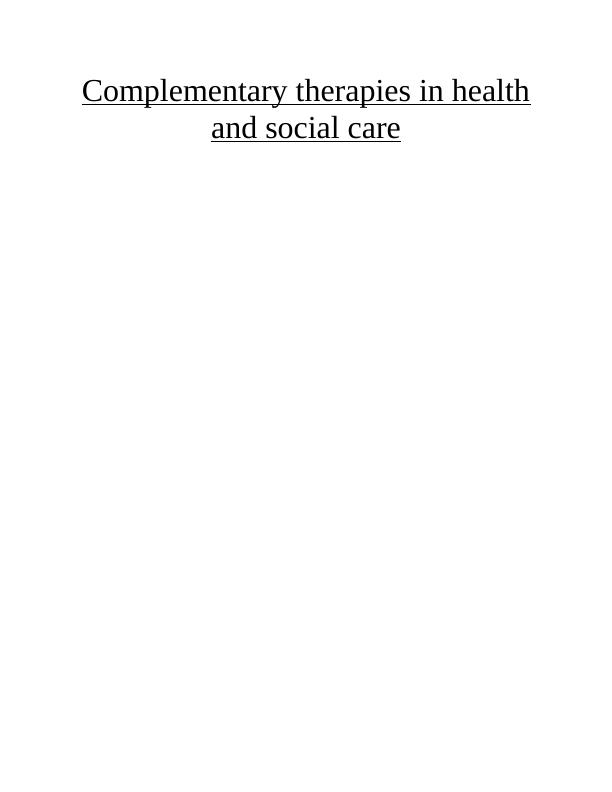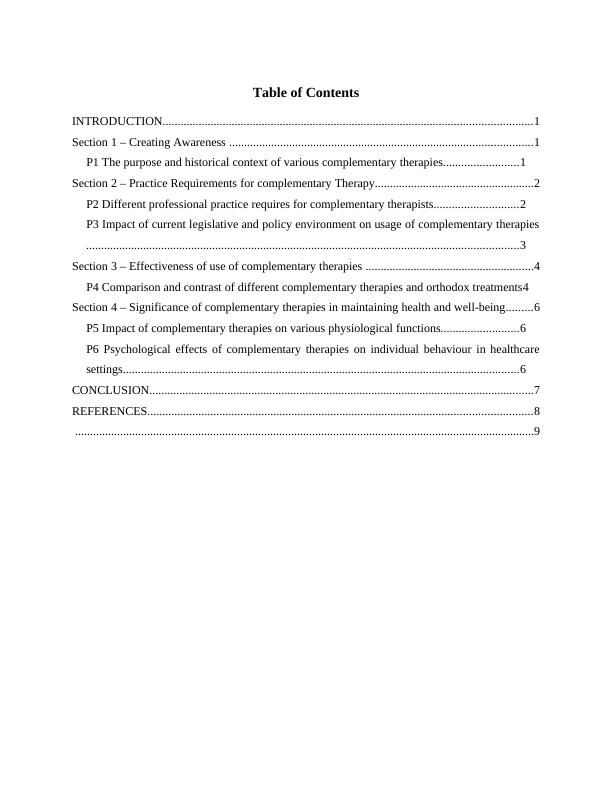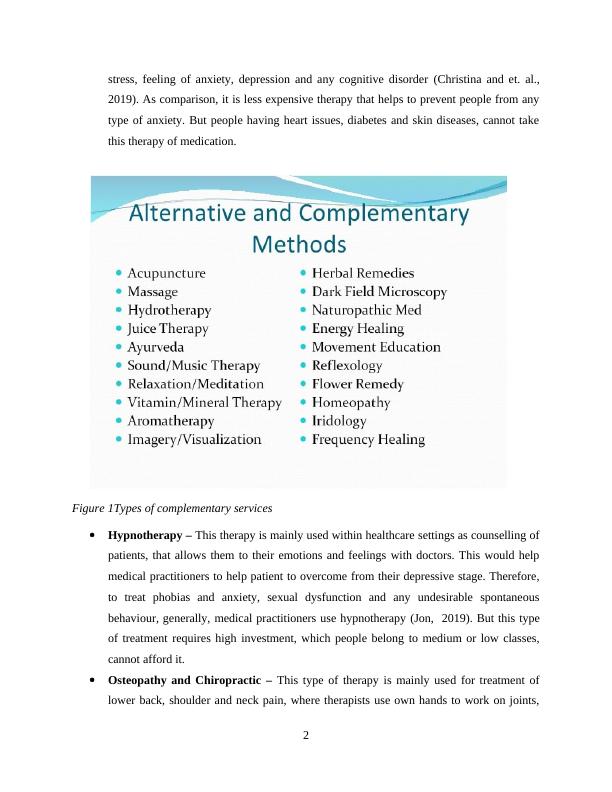Complementary Therapies in Health and Social Care
Added on 2023-01-12
13 Pages3804 Words23 Views
Complementary therapies in health
and social care
and social care

Table of Contents
INTRODUCTION...........................................................................................................................1
Section 1 – Creating Awareness .....................................................................................................1
P1 The purpose and historical context of various complementary therapies.........................1
Section 2 – Practice Requirements for complementary Therapy.....................................................2
P2 Different professional practice requires for complementary therapists............................2
P3 Impact of current legislative and policy environment on usage of complementary therapies
................................................................................................................................................3
Section 3 – Effectiveness of use of complementary therapies ........................................................4
P4 Comparison and contrast of different complementary therapies and orthodox treatments4
Section 4 – Significance of complementary therapies in maintaining health and well-being.........6
P5 Impact of complementary therapies on various physiological functions..........................6
P6 Psychological effects of complementary therapies on individual behaviour in healthcare
settings....................................................................................................................................6
CONCLUSION................................................................................................................................7
REFERENCES................................................................................................................................8
.........................................................................................................................................................9
INTRODUCTION...........................................................................................................................1
Section 1 – Creating Awareness .....................................................................................................1
P1 The purpose and historical context of various complementary therapies.........................1
Section 2 – Practice Requirements for complementary Therapy.....................................................2
P2 Different professional practice requires for complementary therapists............................2
P3 Impact of current legislative and policy environment on usage of complementary therapies
................................................................................................................................................3
Section 3 – Effectiveness of use of complementary therapies ........................................................4
P4 Comparison and contrast of different complementary therapies and orthodox treatments4
Section 4 – Significance of complementary therapies in maintaining health and well-being.........6
P5 Impact of complementary therapies on various physiological functions..........................6
P6 Psychological effects of complementary therapies on individual behaviour in healthcare
settings....................................................................................................................................6
CONCLUSION................................................................................................................................7
REFERENCES................................................................................................................................8
.........................................................................................................................................................9

INTRODUCTION
Complementary therapies can be defined as alternative options, that provided to people to
cope-up from long-term diseases and improve better quality of life (Arcury and et. al., 2019). It
offers the various approaches as conventional and supplement clinical practices which
supporting wellness with traditional art of healing, like yoga, aromatherapy, herbal medicine and
more. However, these practices are not included as standard medical care, but helps in
developing richness in holistic care (Abrahão and et. al., 2019). Under the present report, for
creating awareness about importance of complementary therapies, purpose and historical context
of the same is described,with its principles in healthcare settings. An assessment of regulations
that affect such therapies, with professional practices required to apply same, is also being
discussed. Furthermore, significance of complementary practices for maintaining well-being, is
critically examined by assessing its psychological effects.
Section 1 – Creating Awareness
P1 The purpose and historical context of various complementary therapies
From the last two decades, in UK and other western countries, complementary therapies
are integrating continuously within healthcare settings. It plays a therapeutic role in increasing
richness or quality of nursing in holistic care, for well-beingness of people (Taylor and et. al.,
2019). In NHS and other healthcare organisations of UK, provision of complementary therapies
is mainly established for patients who are suffering from long-lasting pain or having cognitive
disorders and others, such as acupuncture for addiction, aromatherapy for relieving from stress
and depression etc. The purpose and usage of different types of complementary therapies, which
are considered as alternative for medical treatment services are given as below –
Types of complementary therapies:
Acupuncture – It is one of the oldest therapy which is widely used for reducing or
managing pain. This type of therapy helps people to prevent from migraine, long-lasting
neck and joint pain, or pain and sickness after getting chemotherapy or any surgery
(Complementary Therapies, 2020). But if patient having bleeding disorders, then this
therapy could be dangerous for them.
Aromatherapy – Under this therapy, essential oils are used which are extracted from
herbs, to give massage to patients, that help them to overcome from long-lasting pain,
1
Complementary therapies can be defined as alternative options, that provided to people to
cope-up from long-term diseases and improve better quality of life (Arcury and et. al., 2019). It
offers the various approaches as conventional and supplement clinical practices which
supporting wellness with traditional art of healing, like yoga, aromatherapy, herbal medicine and
more. However, these practices are not included as standard medical care, but helps in
developing richness in holistic care (Abrahão and et. al., 2019). Under the present report, for
creating awareness about importance of complementary therapies, purpose and historical context
of the same is described,with its principles in healthcare settings. An assessment of regulations
that affect such therapies, with professional practices required to apply same, is also being
discussed. Furthermore, significance of complementary practices for maintaining well-being, is
critically examined by assessing its psychological effects.
Section 1 – Creating Awareness
P1 The purpose and historical context of various complementary therapies
From the last two decades, in UK and other western countries, complementary therapies
are integrating continuously within healthcare settings. It plays a therapeutic role in increasing
richness or quality of nursing in holistic care, for well-beingness of people (Taylor and et. al.,
2019). In NHS and other healthcare organisations of UK, provision of complementary therapies
is mainly established for patients who are suffering from long-lasting pain or having cognitive
disorders and others, such as acupuncture for addiction, aromatherapy for relieving from stress
and depression etc. The purpose and usage of different types of complementary therapies, which
are considered as alternative for medical treatment services are given as below –
Types of complementary therapies:
Acupuncture – It is one of the oldest therapy which is widely used for reducing or
managing pain. This type of therapy helps people to prevent from migraine, long-lasting
neck and joint pain, or pain and sickness after getting chemotherapy or any surgery
(Complementary Therapies, 2020). But if patient having bleeding disorders, then this
therapy could be dangerous for them.
Aromatherapy – Under this therapy, essential oils are used which are extracted from
herbs, to give massage to patients, that help them to overcome from long-lasting pain,
1

stress, feeling of anxiety, depression and any cognitive disorder (Christina and et. al.,
2019). As comparison, it is less expensive therapy that helps to prevent people from any
type of anxiety. But people having heart issues, diabetes and skin diseases, cannot take
this therapy of medication.
Figure 1Types of complementary services
Hypnotherapy – This therapy is mainly used within healthcare settings as counselling of
patients, that allows them to their emotions and feelings with doctors. This would help
medical practitioners to help patient to overcome from their depressive stage. Therefore,
to treat phobias and anxiety, sexual dysfunction and any undesirable spontaneous
behaviour, generally, medical practitioners use hypnotherapy (Jon, 2019). But this type
of treatment requires high investment, which people belong to medium or low classes,
cannot afford it.
Osteopathy and Chiropractic – This type of therapy is mainly used for treatment of
lower back, shoulder and neck pain, where therapists use own hands to work on joints,
2
2019). As comparison, it is less expensive therapy that helps to prevent people from any
type of anxiety. But people having heart issues, diabetes and skin diseases, cannot take
this therapy of medication.
Figure 1Types of complementary services
Hypnotherapy – This therapy is mainly used within healthcare settings as counselling of
patients, that allows them to their emotions and feelings with doctors. This would help
medical practitioners to help patient to overcome from their depressive stage. Therefore,
to treat phobias and anxiety, sexual dysfunction and any undesirable spontaneous
behaviour, generally, medical practitioners use hypnotherapy (Jon, 2019). But this type
of treatment requires high investment, which people belong to medium or low classes,
cannot afford it.
Osteopathy and Chiropractic – This type of therapy is mainly used for treatment of
lower back, shoulder and neck pain, where therapists use own hands to work on joints,
2

End of preview
Want to access all the pages? Upload your documents or become a member.
Related Documents
Complementary Therapies: Analysis of Massage Therapylg...
|13
|3808
|493
Why Alternative Medicine: Increasing Awareness and Benefitslg...
|3
|708
|71
Complementary Therapies in Health Practicelg...
|14
|4449
|37
Alternative and Complementary Medicine Use for LBP in Australialg...
|11
|2735
|303
ALTERNATIVE THERAPIES.lg...
|12
|3351
|1
Health Disorders: Types, Behaviors, and Treatmentslg...
|5
|786
|92
